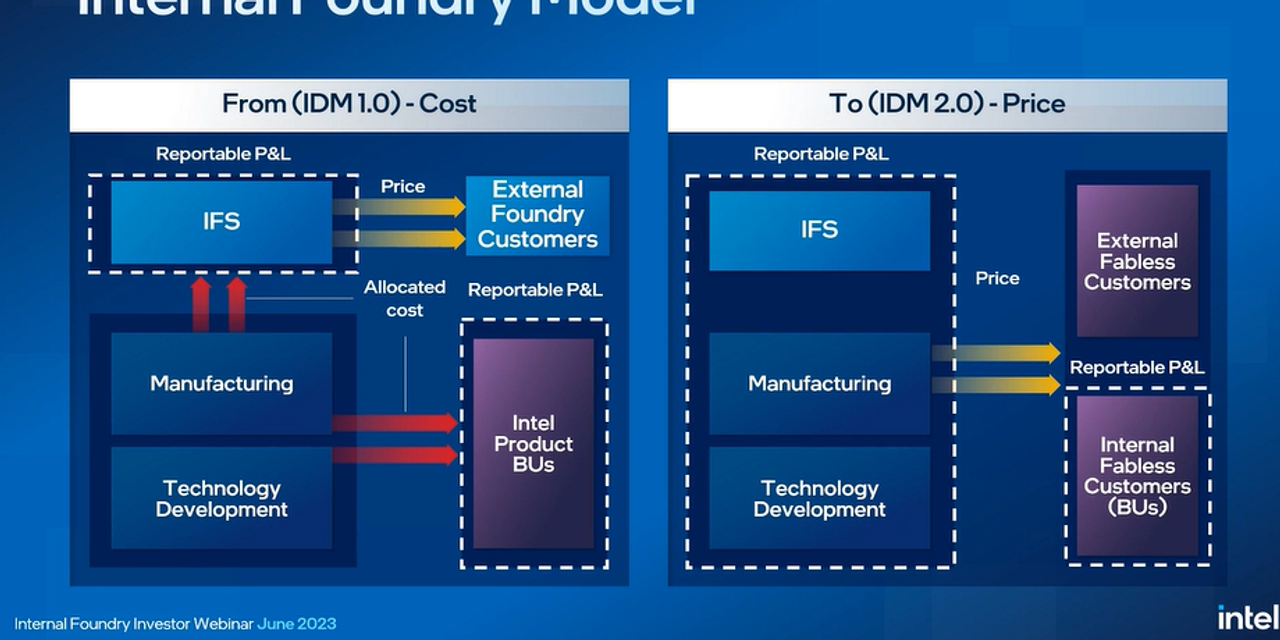Intel Corp.’s stock fell for a second consecutive session Wednesday, and was again the worst performer in the Dow Jones Industrial Average, after the chip maker laid out plans to compete against third-party fab giant Taiwan Semiconductor Manufacturing Co.
Intel’s
INTC,
shares, which had been down about 2% before a late-morning event with Wall Street analysts started, closed down 6% near daily lows at $32.90.
That gave the stock the dubious distinction of being the worst-performing Dow
DJIA,
component for a second session in a row, with Salesforce Inc. shares
CRM,
Wednesday’s second-worst, posting a 3.4% decline. Intel stock has fallen 9.5% in the past two days. On Wednesday, it was also the worst performer in the S&P 500 Index, with Advanced Micro Devices Inc.
AMD,
second-worst, down 5.7%.
For its part, the Dow finished Wednesday down 0.3%, compared with a 2.7% fall by the PHLX Semiconductor Index
SOX,
a 0.5% decline by the S&P 500 index
SPX,
and a 1.2% decline by the tech-heavy Nasdaq Composite Index
COMP,
Intel Chief Financial Officer David Zinsner told analysts earlier Wednesday that the chip maker will start giving its manufacturing business its own profit and loss statement beginning in the first quarter of 2024 as it moves to become competitive in the third-party fab sector.
While Zinsner laid out the goal of being the “second-largest external foundry by 2030” with its Intel Foundry Services, or IFS, business, and forecast being the “second-largest foundry next year, with manufacturing revenue of greater than $20 billion,” Intel has yet to name a major customer that would pose a challenge to TSMC
TSM,
and said it hoped to name one by the end of the year.
As a way of enticing customers, Intel said it was providing more transparency into the performance of its manufacturing arm versus its product business.
“Manufacturing will begin to generate a margin,” Zinsner told analysts during the event.
Intel margins have been under fire since they have fallen well below the 51% to 53% range that Zinsner promised more than a year ago. In its April earnings report, Intel reported gross margins of 38.4%, down from 53.1% in the year-ago period.
Read: Intel stock drops as foundry capacity buildout plans have one analyst predicting a company split
Intel said it will have a more “exhaustive” meeting on IFS in the second half of the year. Intel reports second-quarter earnings in late July.
Read: Intel’s first major contract foundry customer still a mystery as analysts sift through presentation
Intel uses its own foundries — or fabs, those high-tech plants that create the silicon wafers onto which transistors are etched to make microchips — unlike other chip makers that are “fabless,” like Nvidia Corp.
NVDA,
AMD and Apple Inc.
AAPL,
Those companies use third-party fabs like TSMC for their chips.
Read First Take: Intel confirms it will be a long slog for its foundry business
Following the event, analysts wondered whether Intel could hope to take significant market share in the third-party foundry space, which promises to be a long slog for investors.
Earlier Wednesday, before the event, Intel announced it would sell a roughly 20% stake in its IMS Nanofabrication GmbH business to Bain Capital for about $4.3 billion.
From last week: Intel’s stock rocks best week in nearly 14 years as analyst notes a ‘material AI opportunity’
On Tuesday, Intel confirmed reports from over the weekend that it was building new foundry capacity in Germany, Poland and Israel.
Since Chief Executive Pat Gelsinger took over the reins of Intel back in 2021, one of his aims has been to build out fab capacity and take some share from TSMC in third-party foundry work through IFS.
Read: TSMC stock gains on report that Nvidia AI-chip order has boosted production
Read the full article here











